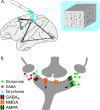Cortical chemoarchitecture shapes macroscale effective functional connectivity patterns in macaque cerebral cortex
- PMID: 26970255
- PMCID: PMC6867501
- DOI: 10.1002/hbm.23141
Cortical chemoarchitecture shapes macroscale effective functional connectivity patterns in macaque cerebral cortex
Abstract
The mammalian cortex is a complex system of-at the microscale level-interconnected neurons and-at the macroscale level-interconnected areas, forming the infrastructure for local and global neural processing and information integration. While the effects of regional chemoarchitecture on local cortical activity are well known, the effect of local neurotransmitter receptor organization on the emergence of large scale region-to-region functional interactions remains poorly understood. Here, we examined reports of effective functional connectivity-as measured by the action of strychnine administration acting on the chemical balance of cortical areas-in relation to underlying regional variation in microscale neurotransmitter receptor density levels in the macaque cortex. Linking cortical variation in microscale receptor density levels to collated information on macroscale functional connectivity of the macaque cortex, we show macroscale patterns of effective corticocortical functional interactions-and in particular, the strength of connectivity of efferent macroscale pathways-to be related to the ratio of excitatory and inhibitory neurotransmitter receptor densities of cortical areas. Our findings provide evidence for the microscale chemoarchitecture of cortical areas to have a direct stimulating influence on the emergence of macroscale functional connectivity patterns in the mammalian brain. Hum Brain Mapp 37:1856-1865, 2016. © 2016 Wiley Periodicals, Inc.
Keywords: brain networks; functional connectivity; graph theory; neurotransmitter receptors; strychnine.
© 2016 Wiley Periodicals, Inc.
Figures




References
-
- Adachi Y, Osada T, Sporns O, Watanabe T, Matsui T, Miyamoto K, Miyashita Y (2012): Functional connectivity between anatomically unconnected areas is shaped by collective network‐level effects in the macaque cortex. Cereb Cortex 22:1586–1592. - PubMed
-
- Amunts K, von Cramon DY (2006): The anatomical segregation of the frontal cortex: What does it mean for function? Cortex 42:525–528. - PubMed
-
- Brown DA (2010): Muscarinic acetylcholine receptors (mAChRs) in the nervous system: Some functions and mechanisms. J Mol Neurosci 41:340–346. - PubMed
-
- Choquet D, Triller A (2013): The dynamic synapse. Neuron 80:691–703. - PubMed
Publication types
MeSH terms
Substances
LinkOut - more resources
Full Text Sources
Other Literature Sources

